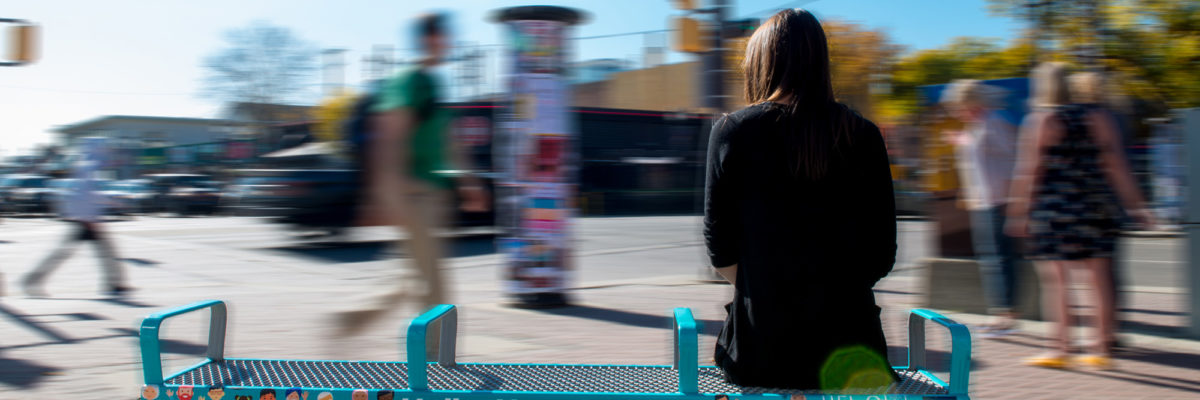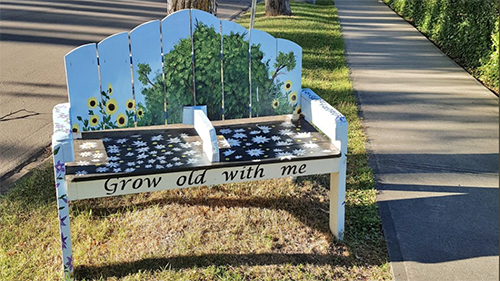


Happening Today
Sorry, event listing is not available.

Edmonton’s benches you won’t sit on
Budget constraints make a mental health initiative less inviting
Written by Mel Priestley
TLDR
Edmonton’s Buddy benches aren’t exactly for sitting, but they are an attempt to encourage discussion about mental health and urban isolation.
It’s late afternoon on a sunny Thursday in August and I’m sitting on one of Edmonton’s new buddy benches, hoping to make a friend.
The bench is on 103 Street downtown, outside the Cathedral Close senior’s home. A handful of seniors have already assembled in a shady seating area behind me, on lawn chairs that look a lot more comfortable than the repurposed bus bench I’m sitting on.
A steady stream of pedestrians glance at me as they pass but no one stops. Then, success! A middle-aged man sits down beside me. I turn slightly to look at him, smiling. He avoids eye contact, takes out his vape and starts cleaning it. After a few minutes he stands up, walks a few metres away and then starts puffing. I guess he didn’t want to be my buddy.
Hello, how are you?
This program is actually a combination of two Edmonton city council initiatives, the Council Initiative on Urban Isolation and Mental Health and the Council Initiative on Seniors. Its goal is to encourage Edmontonians to connect with others in their communities to help prevent social isolation, which effects people living in busy cities and those in seniors populations.
The “Hello” campaign is supposed to be an easy way for Edmontonians to show others the city can be a supportive place, through smiles, offering to help someone out or dropping in on someone for a visit. Buddy benches are brightly coloured or inviting in other ways to encourage lonely people to sit down and have others join them and strike up a conversation.
If you or someone you know is feeling social isolation, or just need to talk, the City’s got people and places to call on its website, and you can always call 211 for a list of mental health resources in Edmonton.
The City of Edmonton installed a series of 13 buddy benches around the city this summer. It’s a pilot project under the city’s “Hello, How Are You?” campaign, which is part of city council’s Urban Isolation and Mental Health initiative. The benches are a cheery ocean blue colour, featuring the Hello, How Are You? text and graphics. There are also some decals stuck to the ground in front of them to draw attention — or there were — some started lifting up in the rain and were removed by the City to avoid a slipping hazard.
The project was inspired by a local elementary student who had a buddy bench at his school and mentioned it might be useful to his grandmother, after learning she was involved in a video project about loneliness in retirement. She passed along his idea to a contact at the City. Buddy benches have been around school yards and playgrounds for a few years prior. A student in Pennsylvania is credited as bringing them to the U.S. in 2014, after which they went viral. Now you can even buy pre-fabricated Buddy benches at Costco.
Edmonton may be the first city to roll out buddy benches for an adult crowd. But will anyone actually use them?
Probably not, admits Councillor Scott McKeen, who instigated the Urban Isolation and Mental Health initiative. Actually, that’s not the point of this project.
“Do I expect widespread use of this as a way for almost like speed dating, where you’d meet a new friend – and I don’t mean a lover, I mean a friend – no, I don’t think that,” McKeen says. “I think the effort is almost more consciousness-raising rather than practically trying to solve the problem.”
McKeen describes the buddy benches as a social experiment. If people use them that’s great, he says, but he thinks their purpose is to get people talking about the issue of social isolation – not actually solve it.
“Admitting you’re lonely in a city of almost a million people is to suggest there’s something wrong with you,” McKeen says. “And yet we know that there’s not … buddy benches is another way of saying, subliminally perhaps, that other people suffer this too. Other people are feeling isolated too.”
Combating social isolation is a worthy cause, and the spirit of Edmonton’s buddy benches is certainly admirable. But their design is problematic. As they are repurposed Edmonton Transit bus benches, they are backless and have handrails dividing the bench into three separate sections. You can only sit on them facing straight ahead – not the greatest design if you’re trying to catch someone’s eye or even just acknowledge their presence. The handrails also mean you can’t lounge or lie down on them, and not all body shapes will be able to sit comfortably on them, or at all.
 Buddy benches are just re-purposed ETS benches, which aren't meant for long sits. photo: Jeff Samsonow
Buddy benches are just re-purposed ETS benches, which aren't meant for long sits. photo: Jeff Samsonow
Chelsey Anseeuw, a City of Edmonton social planner who worked on the Buddy Bench project, admits that the city had originally looked at designing its own benches but only had $33,000 for the project. That’s why they went with benches donated by ETS.
“We recognize that there are limitations to using the recycled benches, for sure,” she says. “If we were to have a big budget for the project we probably would have gone with more of like a park bench-type design that had a back for you to be able to rest on there a little bit more comfortably, and just the handrails on the side so that seniors could still get up and down comfortably, but yeah – not with the rails throughout.”
The Hazeldean Community League installed their own buddy bench last July. Designed for children, it’s painted in bright rainbow colours and is U-shaped, so when kids sit down they are facing each other.
Troy Pavlek, president of the Hazeldean Community League, is critical of Edmonton’s buddy bench design. “It’s pretty textbook unpleasant design,” he says. “If we’re trying to get people to go out of their comfort zones and interact with each other and experiment, well, our design of our infrastructure should encourage experimentation, rather than regimented unpleasant design.”
“Forcing people into an unpleasant design isn’t going to make it easy to interact,” he continues. “We need to break down the barriers. So if the case is [that] you need to be permissive with your design, then be permissive with your design.”
Even though the buddy benches were intended to raise awareness only and not actually give people a comfortable place to sit and possibly connect, why can’t we have it both ways? A different design from the outset could have both raised awareness and facilitated social connections. Starting off with an unpleasant design – if not one that’s downright hostile – raises barriers from inception.
The design of a city’s urban spaces and infrastructure has a critical impact on the mental health of its citizens. Robin Mazumder is an occupational therapist who’s studying this concept for his PhD at the University of Waterloo. He lived in Edmonton from 2012 to 2015 and was involved in a number of related projects here, including serving on the board of Make Something Edmonton and the End Poverty taskforce.
Mazumder agrees with McKeen that the symbol of the buddy bench is almost more important than its actual utility. But he also notes that it falls within the larger conversation around defensive or hostile architecture and urban design. He suggests that perhaps the benches could be redesigned in consultation with the public, which has the added effect of making people feel a sense of ownership – even though public spaces and benches are technically already owned by the public.
“By having the community come together and repurpose these things, there’s another element of how they can own space in the public and how they can feel a sense of stewardship over that as well,” he says. “People talk a lot about walkability, but sit-ability is also important, especially for people with physical disabilities, the elderly. So when it comes to seating there’s definitely a dialogue.”
Start looking around Edmonton and you’ll find many examples of hostile architecture. It’s not the kind of urban design that promotes good mental health or the end of urban isolation. While Edmonton’s buddy benches were not intended to be hostile, they may send this message implicitly by virtue of their design. That’s a pretty major flaw.

McKeen admits that the human aspect of urban design is often not considered by City planners. But, as these conversations gain momentum, perhaps this will change – he’s optimistic the buddy benches could be part of a larger shift that needs to happen.
“I’ve joked that we should hire a sociologist or social psychologist for our planning department, so they could review plans and say, ‘Yeah, this is going to scare off people or this will attract people,'” McKeen says. “I think, really, the next stage will be taking this strategy into urban design and planning.”
You have until November 2017 to give your feedback on Edmonton’s Buddy Bench project. (Call or email 311.) The City will compile feedback on the project and present a report to council in spring 2018, which will determine where it goes from there.
Holyroom mural
Written by Mel Priestly. Main art by Samantha Parker.
Questions about this story? Comments? We’d love to hear from you.
If you enjoyed this story, and want to see more like it, consider supporting us.
Support EQ